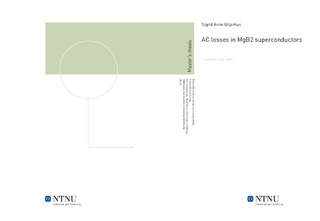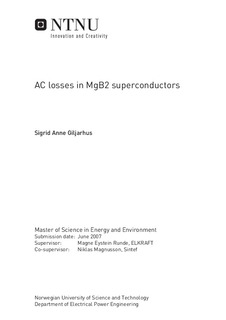| dc.description.abstract | This Master thesis studies losses in superconductors. Losses arise when the superconductor carries alternating current or is placed in an alternating magnetic field. As most power applications involve at least one of the two, loss mechanisms and magnitudes are important when examining the possibility of making superconductor systems competitive to conventional power systems. There are two parts to the task at hand. The first part is a literature study on superconductivity and AC losses in superconductors. A division between two general types of superconductors is presented; type I and II. The Bean model for AC losses in type II superconductors is described, together with equations giving the power law between generated losses and applied magnetic field. In the Bean model, the losses are proportional to the applied field cubed below a limit called the penetration field. Above it, the exponent changes to one. Losses due to coupling of filaments are also treated. The measuring setup used in the AC loss experiments is calorimetric, and the principle behind the method is presented. The superconductor used, magnesium diboride (MgB2), is introduced. The literature study is concluded with short résumés on other AC loss studies done on MgB2, and studies done on one type of high temperature superconductor. The second part is measuring AC losses due to an applied alternating magnetic field in two superconductor samples from different manufacturers. Specific information on the two samples, details on the measuring system, preparations and the measuring procedure is described. The logged data and equations used when processing the results are also listed. Measurements have been performed at six different temperatures; 25, 28.5, 30, 31.5, 35 and 45 K. The magnitude of the applied magnetic field was varied between 3 and 150 mT. Both parallel and perpendicular field directions were applied. Generated losses lead to a temperature increase in the superconductor. The rise in temperature was detected as increased resistivity of a thin copper wire glued onto the sample, as the copper resistivity is temperature dependent. The obtained results are examined in double logarithmic (loglog) and normal axis diagrams, where the main aim is to find loss slopes and penetration fields at the different temperature levels, and to compare these to the Bean model loss equations. In addition, the results are compared to theoretical loss equations for cylindrical conductor geometry. This is done in order to look at the accuracy of the fittings and to compare the penetration fields obtained here to the ones found in loglog diagrams. The results have also been compared to various studies on MgB2 and other superconductor types. The measured loss slopes at fields below the penetration field, found from loglog diagrams, do not fit the Bean model. The slopes are here lower than the applied field cubed. At fields greater than the penetration field, losses are proportional to the applied field, as in the Bean model. Two reasons for the deviations have been discussed; measuring errors and losses being coupling losses. Even if the measuring errors may be considerable due to human reading errors, they would have to be systematic for the losses to fit the Bean model. This is the reason why measuring errors are seen as unlikely to be the grounds for the non-fitting results. The results do also not fit the coupling loss slope and as only one field frequency has been used, the obtained results are not enough to support or reject this theory. Due to the deviation from the Bean model loss slopes the curve fittings to the cylindrical conductor loss equations were mostly poor, as they have the same loss slopes as the Bean model. The penetration fields found from loglog and normal axis diagrams and the curve fitting are not equal. It is establish that the ones found from loglog diagrams should be used. Two of the other studies done on MgB2, which have been summarised in the thesis, fit the Bean model, and the last case did not. The authors found no explanation to the non-fitting results, and have ruled out coupling losses as a viable reason. Studies on the other type of superconductor also represented both cases. Here, some non-fitting results were explained by coupling losses. When comparing loss magnitudes, only one of the samples used in these experiments had as low results as found in two other studies. | nb_NO |

